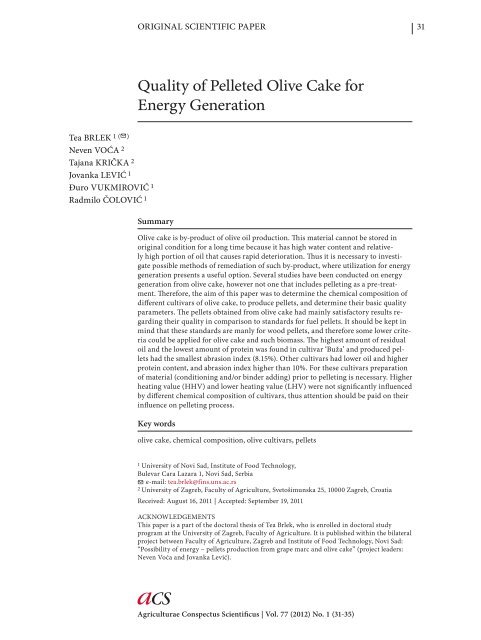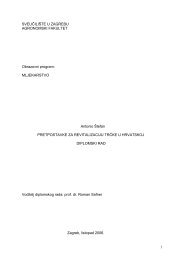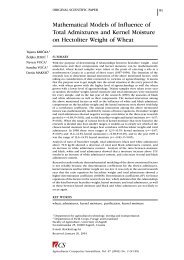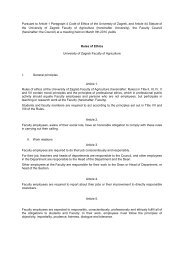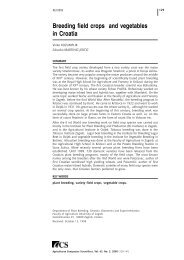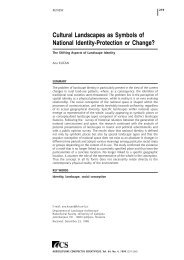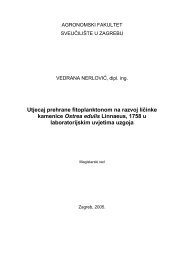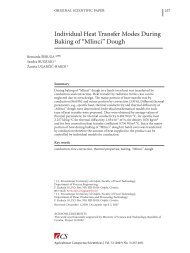Quality of Pelleted Olive Cake for Energy Generation
Quality of Pelleted Olive Cake for Energy Generation
Quality of Pelleted Olive Cake for Energy Generation
Create successful ePaper yourself
Turn your PDF publications into a flip-book with our unique Google optimized e-Paper software.
ORIGINAL SCIENTIFIC PAPER31<strong>Quality</strong> <strong>of</strong> <strong>Pelleted</strong> <strong>Olive</strong> <strong>Cake</strong> <strong>for</strong><strong>Energy</strong> <strong>Generation</strong>Tea BRLEK 1 ( )Neven VOĆA 2Tajana KRIČKA 2Jovanka LEVIĆ 1Đuro VUKMIROVIĆ 1Radmilo ČOLOVIĆ 1Summary<strong>Olive</strong> cake is by-product <strong>of</strong> olive oil production. This material cannot be stored inoriginal condition <strong>for</strong> a long time because it has high water content and relativelyhigh portion <strong>of</strong> oil that causes rapid deterioration. Thus it is necessary to investigatepossible methods <strong>of</strong> remediation <strong>of</strong> such by-product, where utilization <strong>for</strong> energygeneration presents a useful option. Several studies have been conducted on energygeneration from olive cake, however not one that includes pelleting as a pre-treatment.There<strong>for</strong>e, the aim <strong>of</strong> this paper was to determine the chemical composition <strong>of</strong>different cultivars <strong>of</strong> olive cake, to produce pellets, and determine their basic qualityparameters. The pellets obtained from olive cake had mainly satisfactory results regardingtheir quality in comparison to standards <strong>for</strong> fuel pellets. It should be kept inmind that these standards are manly <strong>for</strong> wood pellets, and there<strong>for</strong>e some lower criteriacould be applied <strong>for</strong> olive cake and such biomass. The highest amount <strong>of</strong> residualoil and the lowest amount <strong>of</strong> protein was found in cultivar ‘Buža’ and produced pelletshad the smallest abrasion index (8.15%). Other cultivars had lower oil and higherprotein content, and abrasion index higher than 10%. For these cultivars preparation<strong>of</strong> material (conditioning and/or binder adding) prior to pelleting is necessary. Higherheating value (HHV) and lower heating value (LHV) were not significantly influencedby different chemical composition <strong>of</strong> cultivars, thus attention should be paid on theirinfluence on pelleting process.Key wordsolive cake, chemical composition, olive cultivars, pellets1 University <strong>of</strong> Novi Sad, Institute <strong>of</strong> Food Technology,Bulevar Cara Lazara 1, Novi Sad, Serbiae-mail: tea.brlek@fins.uns.ac.rs2 University <strong>of</strong> Zagreb, Faculty <strong>of</strong> Agriculture, Svetošimunska 25, 10000 Zagreb, CroatiaReceived: August 16, 2011 | Accepted: September 19, 2011ACKNOWLEDGEMENTSThis paper is a part <strong>of</strong> the doctoral thesis <strong>of</strong> Tea Brlek, who is enrolled in doctoral studyprogram at the University <strong>of</strong> Zagreb, Faculty <strong>of</strong> Agriculture. It is published within the bilateralproject between Faculty <strong>of</strong> Agriculture, Zagreb and Institute <strong>of</strong> Food Technology, Novi Sad:“Possibility <strong>of</strong> energy – pellets production from grape marc and olive cake” (project leaders:Neven Voća and Jovanka Lević).Agriculturae Conspectus Scientificus | Vol. 77 (2012) No. 1 (31-35)
32 Tea BRLEK, Neven VOĆA, Tajana KRIČKA, Jovanka LEVIĆ, Đuro VUKMIROVIĆ, Radmilo ČOLOVIĆIntroductionThe production <strong>of</strong> olive oil has raised over the past decade,as a result <strong>of</strong> objective circumstances: incentives (state, countyand local), high price <strong>of</strong> oil, positive attitudes about olive oil nutritionalvalue, the introduction <strong>of</strong> new technology <strong>of</strong> growingolives, a sufficient number <strong>of</strong> mills, etc. In Croatia, the annualproduction <strong>of</strong> olive oil is 5 to 5.5 million liters, with an averageyield per tree from 3.1 to 11.6 kg <strong>of</strong> olives (Statistički ljetopis,2009). In the production <strong>of</strong> olive oil three different technologiesare used: traditional pressing technologies, a two-phase decantingsystem, and the three-phase decanting system (Koprivnjak, 2006).Regardless the production system, a by-product similar toa paste is produced and it is called olive cake or pomace. Suchmaterial is difficult to manipulate, it dries slowly and many difficultiesarise with its disposal (Fokaides and Tsiftes, 2007).<strong>Olive</strong> cake is a mushy mass <strong>of</strong> pulp residues and pits <strong>of</strong> thefruit, which contains a large amount <strong>of</strong> organic substances, amongwhich is about 4% <strong>of</strong> oil, what gives olive cake a high potential<strong>for</strong> energy production (Niaounakis and Halvadakis, 2006; Roiget al, 2006). Estimated quantity <strong>of</strong> waste generated in the production<strong>of</strong> olive oil in the EU is about 6.8 million tons per year(Taralas and Kontominas, 2006). Croatia produces about 30 000tones <strong>of</strong> olives annually, which generates about 12 000 tones <strong>of</strong>fresh olive cake (Statistički ljetopis, 2009). The main chemicalconstituents <strong>of</strong> olive cake are cellulose, lignin, protein, oil, polyphenolsand water, but chemical composition <strong>of</strong> individual cultivarscould not be found in literature. The proportion <strong>of</strong> watervaries depending on the process <strong>of</strong> olive processing, and it islower in cake obtained by pressing, than in the one obtained bydecanting process (Alburquerque et al., 2004).Given the high proportion <strong>of</strong> water and still quite a highproportion <strong>of</strong> residual oil, crude olive cake cannot be stored inits original condition <strong>for</strong> long. If exposed to the air it quicklybecomes rancid. <strong>Olive</strong> cake obtained by the process <strong>of</strong> decantingdeteriorates after only 4-5 days, and the one obtained bypressing, after 14-15 days. The reason is high water content. Dryolive cake, according to the literature can be stored <strong>for</strong> about 45days, while the de-oiled and dried olive cake can be stored <strong>for</strong>about a year (Kiritsakis, 1998). <strong>Olive</strong> cake spoils quickly becausethe high moisture content helps the hydrolysis <strong>of</strong> triglycerides,which causes a significant increase in acidity (Kiritsakis, 1998).Because <strong>of</strong> these characteristics olive cake is a potential threatto the environment if disposed in an uncontrolled manner. Basedon European Union regulations, organic waste cannot be disposedwithout its previous processing. For these reasons it isnecessary to further analyze this material in terms <strong>of</strong> its chemicalcomposition, as well as to investigate possible methods <strong>of</strong>remediation <strong>of</strong> such by-products, where utilization <strong>for</strong> energygeneration presents a useful option (Voća et al., 2010).The easiest way to generate energy from olive cake is directcombustion. Depending on the plant it can be incineratedin its original state, dried or pelletized. Several studies havebeen conducted on energy generation from olive cake (Al-Widyan et al., 2006; Atimtay i Varol, 2009; Caputo et al.,2003; Miranda et al., 2007), however not one that includespelleting as a pre-treatment. Pelleting <strong>of</strong> biomass providesbenefits in terms <strong>of</strong> higher bulk density, and at the sametime higher heating value per mass unit. It also facilitateshandling and transport. There<strong>for</strong>e, the aim <strong>of</strong> this paper wasto determine the chemical composition <strong>of</strong> different cultivars<strong>of</strong> olive cake, to produce pellets from olive cake, and todetermine their basic quality parameters.Material and methods<strong>Olive</strong> cake was obtained from olive oil producers in Istria,Croatia. <strong>Olive</strong> oil is commonly produced as a mixture <strong>of</strong> cultivars,but <strong>for</strong> this investigation four different cultivars havebeen produced and analyzed separately: ‘Pendolino’, ‘Leccino’,‘Buža’ and ‘Istarska Bjelica’. The cake was from a mill that usesthree-phase decanting system; there<strong>for</strong>e their by-product is cakewhich contains approximately 50% <strong>of</strong> moisture. <strong>Olive</strong> cake wasdried in a dryer at 40°C, until it had moisture content <strong>of</strong> approximately7%. The material was analyzed <strong>for</strong> dry matter content(NREL/TP-510-42621), ash content (NREL/TP-510-42622),crude protein (Kjeldahl method), crude fiber (AOAC 962.10), oil(ISO 734-1:2006), C, H, N (CEN/TS 15104:2005) and S (CEN/TS 15289:2006). Dried cake was milled on a hammer mill, with4 mm sieve openings, and the material was rehydrated to 12%moisture and pelletized at the pilot plant <strong>of</strong> the Institute <strong>of</strong> FoodTechnology, Novi Sad, Serbia on a flat die pellet press 14-175,AMANDUS KAHL GmbH & Co. KG (Germany), using 6 mmdie opening and thickness 48 mm. After pelleting, pellets werestored <strong>for</strong> 24 hours under room conditions in order to achievestabile moisture and temperature. The obtained pellets wereanalyzed: bulk density, hardness, abrasion, density (CEN/TS15150:2005), higher heating value (HHV) (determined by adiabaticbomb calorimeter IKA C 200), lower heating value LHV(CEN/TS 14918:2005), moisture content 24 hours after pelleting(NREL/TP-510-42621) and ash content (NREL/TP-510-42622).The length <strong>of</strong> pellets was also measured (a random sample <strong>of</strong> 15),with micrometer caliper. All analyses were made in triplicate,except hardness, which was done in ten replicates.Bulk density was measured with a bulk density tester,Tonindustrie, West und Goslar, Germany. Pellet hardness wasdetermined with “Pellet Hardness Tester“, AMANDUS KAHLGmbH & Co. KG, Germany. The average <strong>of</strong> 15 mesurments isreferred to as the “Kahl hardness“ (KH) <strong>of</strong> the pellet. Abrasion<strong>of</strong> pellets was determined with “Pellet Durability Tester“, Bühler,Switzerland.Statistical Analysis System (Statistica, Tulsa, Oklahoma,USA) was used <strong>for</strong> analyzing variations (analysis <strong>of</strong> variance– ANOVA) and least significant differences (LSD). The level <strong>of</strong>significance was set at p
<strong>Quality</strong> <strong>of</strong> <strong>Pelleted</strong> <strong>Olive</strong> <strong>Cake</strong> <strong>for</strong> <strong>Energy</strong> <strong>Generation</strong>33Table 1. Chemical composition <strong>of</strong> olive cakeDry basis (%) Pendolino Leccino I. Bjelica BužapH 5.13±0.02 c 6.24±0.23 b 4.47±0.02 d 7.07±0.06 aCrude protein 6.61±0.19 a 6.68±0.10 a 6.17±0.10 b 4.39±0.10 cCrude fiber 38.91±0.04 a 40.72±0.04 a 40.09±0.08 a 40.34±0.03 aOil 4.50±0.02 c 4.58±0.07 c 6.28±0.02 b 9.74±0.04 aAsh 1.60±0.03 c 1.56±0.02 c 1.84±0.01 b 2.07±0.07 aC55.19±0.77 a 56.64±0.56 a 55.54±0.72 a 54.21±0.63 bH 7.79±0.27 b 8.10±0.08 a 7.38±0.34 b 7.52±0.24 bN 1.06±0.03 a 1.07±0.02 a 0.99±0.02 b 0.70±0.02 cS0.084±0.01 a 0.083±0.01 a 0.069±0.01 b 0.068±0.01 bThe results are presented as mean±SD; Different letter within the same rowindicate significant differences (p ≤0.05)Table 2. Results <strong>of</strong> the analyses <strong>of</strong> olive cake pelletsParameter Pendolino Leccino I. Bjelica BužaBulk density 618.33±2.89 a 601.67±2.89 b 578.33±2.89 c 601.97±2.89 b(kg/m 3 )Hardness (KH) 9.46±2.70 a 10.32±1.79 a 9.30±1.68 a 7.33±0 .92 bAbrasion (%) 11.22±0.09 c 15.22±0.03 a 13.52±0.39 b 8.15±0.03 dDensity (g/cm 3 ) 1.26±0.01 a 1.26±0.01 a 1.23±0.01 b 1.23±0.00 bLength (mm) 7.35±0.54 b 7.51±0.34 b 10.87±0.36 a 7.17±0.23 bMoisture (%) 7.48±0.01 a 6.65±0.04 c 7.10±0.01 b 5.03±0.02 dAsh (%) 1.88±0.02 b 1.77±0.01 c 1.85±0.01 b 1.91±0.01 aHHV (MJ/kg) 22.91±0.13 a 22.66±0.01 a 22.92±0.13 a 22.63±0.26 aLHV (MJ/kg) 21.22±0.18 a 20.90±0.01 a 21.3±0.16 a 20.99±0.22 aThe results are presented as mean±SD; Different letter within the same rowindicate significant differences (p ≤0.05)Protein content in samples was slightly above 6.00% in‘Pendolino’, ‘Leccino’ and ‘Istarska Bjelica’ samples and 4.39 wasdetermined <strong>for</strong> ‘Buža’. Significant difference was found betweencultivars, except between ‘Pendolino’ and ‘Leccino’. All the valuesare in accordance with literature data, where Alburquerque et al.(2004) determined protein content from 4.3 to 11.5%.Oil content was significantly different among cultivars, except‘Pendolino’ and ‘Leccino’, whose oil contents were alike (4.50and 4.58, respectively). The highest content was determined <strong>for</strong>‘Buža’ (9.72 %). Tekin i Dalgıç (2000) determined oil content inolive cake to have an average value <strong>of</strong> 8.2%, Alburquerque et al.(2004) have had samples with oil content between 7.7 and 19%,and Fokaides and Tsiftes (2007) determined 6.68%.Crude fiber content <strong>of</strong> the material was around 40% <strong>for</strong> allthe samples. Cellulose along with lignin is a major chemicalcomponent in olive cake (Alburquerque et al., 2004; Niaounakisand Halvadakis, 2006).Ash content <strong>of</strong> raw olive cake, was the highest in ‘Buža’ samples(2.07%), with significant difference determined among cultivars,except between ‘Pendolino’ and ‘Leccino’. Average value <strong>of</strong>ash content in olive cake, in literature, is between 2.0 and 15.1%(Baeta-Hall et al., 2005; Alburquerque et al., 2004; Miranda etal., 2007; Al-Widyan, 2006).The ultimate analyses results (C, H, N, S) were in accordancewith available literature data (Al-Widyan, 2006; Chouchene et al.,2010; Miranda et al., 2007). A significant difference was foundamong cultivars mainly <strong>for</strong> nitrogen. Sulphur content was low,and this is important when using olive cake <strong>for</strong> energy generationthrough combustion, because sulphur creates SO 2 , whichcontributes to acid rain <strong>for</strong>mation. Nitrogen is also importantto consider in the same manner, due to <strong>for</strong>mation <strong>of</strong> NO x , whichcauses environmental pollution. Carbon and hydrogen contentsare linked to heating value <strong>of</strong> the biomass.In Table 2 physical characteristics <strong>of</strong> olive cake pellets aregiven with respect to the cultivar <strong>of</strong> olives. According to desireduse <strong>of</strong> pellets different characteristics are important. <strong>Olive</strong> cakepellets can be used as a fuel <strong>for</strong> biomass boilers, <strong>for</strong> energy generation,and were tested primary <strong>for</strong> that purpose in this study.However, olive cake pellets can also be used as a component infeed <strong>for</strong> ruminants (Brlek, 2010).The lowest bulk density was recorded <strong>for</strong> ‘Istarska Bjelica’,and it was 578.33 kg/m 3 , while all other cultivars had bulk densityabove 600 kg/m 3 , what is in accordance to Swedish StandardSS 18 71 20, which defines quality parameters <strong>for</strong> fuel pellets.Bulk density impacts transportation and storage capacities selection(Obernberger and Thek, 2004).Significant difference was determined in hardness only <strong>for</strong>‘Buža’, which had the lowest hardness (7.33 KH), and that couldbe assigned to the highest oil content (9.74%), which could makethe pellet s<strong>of</strong>ter, as well as the lowest protein content that actsas pellet binder (Thomas et al., 1998). Hardness is a parameterimportant <strong>for</strong> the nutrition <strong>of</strong> animals, and there<strong>for</strong>e is not <strong>of</strong>great importance <strong>for</strong> fuel quality. Nevertheless it can be mentionedthat pellets obtained from olive cake in this study withthe lowest hardness could be used as ruminant feed (Čolovićet al., 2010). For the other cultivars adding water in to the rawmaterialor conditioning with steam could decrease the hardness(Vukmirović et al., 2010), making the pellets more suitable<strong>for</strong> animal feed.Abrasion <strong>of</strong> pellets, with significant differences between allcultivar, was from 8.15 to 15.22 %, which is higher than proscribedby norms <strong>for</strong> pellet fuels: < 2.3% (ÖNORM M 7135).This could be lowered also by conditioning the material or byadding binder. Conditioning raises the moisture content <strong>of</strong> thematerial, as well as exposing it to higher temperatures, whichfacilitates particle binding (Thomas at al., 1997). This parameterhas to be considered in transportation and combustion systems,while higher abrasion can cause malfunctioning <strong>of</strong> the feedingsystem. Higher abrasion also means larger dust emissions(Obernberger and Thek, 2004).Density <strong>of</strong> the pellets didn’t show significant differencebetween ‘Pendolino’ and ‘Leccino’ (1.26 g/cm 3 ), as well as between‘Istarska Bjelica’ and ‘Buža’ (1.23 g/cm 3 ). This parameteris important <strong>for</strong> combustion properties as dense materialsshow longer burnout time (Obernberger and Thek, 2004) andthe values were in accordance with ÖNORM M 7135 and DINplus, 51731 (>1.12 g/cm 3 ).Pellets obtained from ‘Istarska Bjelica’ were the longest (10.87mm) while other cultivars didn’t show significant difference (approximately7 mm). The guiding value <strong>for</strong> length <strong>of</strong> fuel pellets,proscribed by ÖNORM M 7135 is
34 Tea BRLEK, Neven VOĆA, Tajana KRIČKA, Jovanka LEVIĆ, Đuro VUKMIROVIĆ, Radmilo ČOLOVIĆAsh content <strong>of</strong> the pellets was in range from 1.77 to 1.91%,which is higher than proscribed by standards (SS 18 71 20,ÖNORM M 7135) (max 1.5 % in SS 18 71 20) <strong>for</strong> fuel pellets.It is better <strong>for</strong> pellets to have lower ash content, while it causeslag and deposit <strong>for</strong>mation in the combustion furnace, and demandsemptying <strong>of</strong> the ash box (Obernberger and Thek, 2004).Higher heating values (HHV) (gross calorific value) werejust above 22.6 MJ/kg (dry basis), and are within the ranges determined<strong>for</strong> olive cake as a raw-material <strong>for</strong> combustion (Al-Widyan, 2006; Chouchene et al., 2010; Miranda et al., 2007).Lower or net heating values (LHV) were from 20.90 to 21.32MJ/kg, which agrees with standards <strong>for</strong> fuel pellets (SS 18 7120, ÖNORM M 7135, DIN plus, 51731; ≥18 MJ/kg), as well aswith previous investigations (Al-Widyan, 2006; Chouchene etal., 2010; Miranda et al., 2007). Carbon and hydrogen contentcontribute positively to HHV, and there<strong>for</strong>e wood fuels haveslightly higher HHV values (Obernberger et al., 2006). Owningto its high energetic values, olive cake can present great renewableenergy source, and could be used in olive oil mills as energy<strong>for</strong> processing.ConclusionThe results <strong>of</strong> chemical analyses <strong>of</strong> olive cake show that variationsexist among different cultivars <strong>of</strong> olive cake, there<strong>for</strong>e itwould be interesting to further investigate olive cake chemicalcomposition, mainly <strong>for</strong> oil, crude protein and crude fiber content.Also the fibre content should be further analysed, in terms<strong>of</strong> total fibre content, as well as its components (cellulose, hemicellulosesand lignin), because olive cake is mainly lingo-cellulosicmaterial. There is also considerable amount <strong>of</strong> residual oilin olive cake, which has in this study facilitate the pelleting process,and made possible <strong>for</strong> olive cake to be pelletized without anymaterial preparation (conditioning and/or binder adding), dueto lubricating effect, which makes the process more economical.Ultimate analyses showed low sulphur content, what meetsthe fuel pellet standards criteria, and this makes olive cake anenvironment-friendly fuel.Since there are no available data on chemical composition<strong>of</strong> individual cultivars <strong>of</strong> olive cake, this investigation contributesin that sense.The pellets obtained from olive cake had mainly satisfactorycharacteristics regarding their quality in comparison tostandards <strong>for</strong> fuel pellets. It should be kept in mind that thesestandards are manly <strong>for</strong> wood, and wood-residue pellets, andthere<strong>for</strong>e some lower criteria could be applied <strong>for</strong> olive cakeand other agricultural biomass pellets. Due to their high heatingvalues olive cake pellets present a good fuel, which is ecologicallybeneficial and at the same time, gives a solution to aproblem <strong>of</strong> olive cake utilization.Differences among cultivars did not impact HHV and LHVbut were important <strong>for</strong> pelleting process, especially the oil content.ReferencesAlburquerque, J.A., Gonzalvez, J., Garcıa, D., Cegarra, J. (2004):Agrochemical characterisation <strong>of</strong> ‘‘alperujo’’, a solid by-product<strong>of</strong> the two-phase centrifugation method <strong>for</strong> olive oil extraction.Bioresource Technology 91, 195–200.Al-Widyan, M.I., Tashtoush, G., Hamasha, A.M. (2006):Combustion and emissions <strong>of</strong> pulverized olive cake in tube furnace.<strong>Energy</strong> Conversion and Management 47; 1588–1596.Atimtay, A.T., Varol, M. (2009): Investigation <strong>of</strong> co-combustion <strong>of</strong>coal and olive cake in a bubbling fluidized bed with secondaryair injection. Fuel 88, 1000–1008.Baeta-Hall, L., Saagua, M.C., Bartolomeu, M.L., Anselmo, A.M.,Rosa, M.F., (2005): Biodegradation <strong>of</strong> olive oil husks in compostingaerated piles. Bioresource Technology 96, 1; 69–78.Brlek, T.; Voća, N.; Krička, T.; Bilandžija, N.; Matin, A.; Jurišić,V. (2010): Technological properties and preparation <strong>of</strong> olivecake as a feed component. In: Lević, J. (eds) Proceedings XIVInterantional Symp Feed Tech, Novi Sad, Srbija: Institute <strong>for</strong>food technology, pp 150-157.Caputo A. C., Scacchia F., Pelagagge P. M. (2003): Disposal <strong>of</strong> byproductsin olive oil industry: Waste-to-energy solutions,Applied Thermal Engineering 23, 197–214.Chouchene, A., Jeguirim, M., Khiarib, B., Zagroubac, F., Trouvea,G. (2010): Thermal degradation <strong>of</strong> olive solid waste: Influence <strong>of</strong>particle size and oxygen concentration. Resources, Conservationand Recycling, 54; 271-277.Čolović, R., Vukmirović, Đ., Matulaitis, R., Bliznikas, S., Uchockis,V., Juskiene, V., Lević, J. (2010),: Effect <strong>of</strong> die channel pressway length on physical quality <strong>of</strong> pelleted cattle feed, FoodProcessing <strong>Quality</strong> & Safety, Journal <strong>of</strong> Institute <strong>for</strong> FoodTechnology in Novi Sad Vol. 37, Br. 1, str. 1-6.Fokaides .A. , Tsiftes, K. (2007): Utilisation <strong>of</strong> <strong>Olive</strong> Husk inenergy sector in Cyprus, Renewable <strong>Energy</strong> Sources & <strong>Energy</strong>Efficiency, 28-30, Nicosia, Cyprus.Kiritsakis, K.A.,: <strong>Olive</strong> oil – from the tree to the table, Food &Nutrition Press, Inc., Trumbull, Connecticut , USA 1998, 75– 85.Koprivnjak, O. (2006): Djevičansko maslinovo ulje od masline dostola, MIH, Poreč.Miranda, M.T., Cabanillas, A., Rojas, S. , Montero, I. , Ruiz, A.(2007): Combined combustion <strong>of</strong> various phases <strong>of</strong> olive wastesin a conventional combustor. Fuel 86; 367–372.Niaounakis M., Halvadakis P., (2006). <strong>Olive</strong> processing waste management,Elsevier, Ox<strong>for</strong>d, UK, 23 – 64.Obernberger I, Thek G. (2004): Physical characterisation and chemicalcomposition <strong>of</strong> densified biomass fuels with regard to theircombustion behaviour. Biomass Bioenergy; 27:653–69.Obernberger, I. Thomas Brunner, T., Bärnthaler, G. (2006):Chemical properties <strong>of</strong> solid bi<strong>of</strong>uels—significance and impact.Biomass and Bioenergy 30; 973–982.STATISTICA (Data Analysis S<strong>of</strong>tware System), v.8.0 (2006). Stat-S<strong>of</strong>t, Inc, Tulsa, Oklahoma, USA (www. stats<strong>of</strong>t.com).Taralas G., Kontominas, M.G. (2006): Pyrolysis <strong>of</strong> solid residuescommencing from the olive oil food industry <strong>for</strong> potentialhydrogen production. Journal <strong>of</strong> Analytical and AppliedPyrolysis 76; 109–116.Tekin, A.R., Dalgıç, A.C. (2000): Biogas production from olive pomace.Resources, Conservation and Recycling 30; 301–313.Thomas, M., van Vliet, T., van der Poel, A.F.B. (1998) Physical quality<strong>of</strong> pelleted animal feed. 3. Contribution <strong>of</strong> feedstuff components.Animal Feed Science Technology 70; 59-78.Thomas, M., van der Poel, A.F.B. (1996): Physical quality <strong>of</strong> pelletedanimal feed: 1. Criteria <strong>for</strong> pellet quality. Animal Feed ScienceTechnology 61; 89-112.Thomas, M., van Zuilichem, D.J., van der Poel, A.F.B. (1997):Physical quality <strong>of</strong> pelleted animal feed. 2. Contribution <strong>of</strong> processesand its conditions. Animal Feed Science Technology 64;173-192.Agric. conspec. sci. Vol. 77 (2012) No. 1
<strong>Quality</strong> <strong>of</strong> <strong>Pelleted</strong> <strong>Olive</strong> <strong>Cake</strong> <strong>for</strong> <strong>Energy</strong> <strong>Generation</strong>35Roig, A., Cayuela, M.L., Sanchez-Monedero, M.A. (2006): An overviewon olive mill wastes and their valorisation methods. WasteManagement 26, 960–969.Statistički ljetopis, 2009, Hrvatski državni zavod za statistiku.Voća, N.; Krička, T.; Brlek Savić, T.; Matin, A.; Jurišić, V. (2010):Residue after wine and olive oil production as a raw material <strong>for</strong>thermal energy generation. Časopis za procesnu tehniku i energetikuu poljoprivredi – Journal on Processing and <strong>Energy</strong> inAgriculture. 14, 2; 69-7.Vukmirović, Đ., Ivanov, D., Čolović, R., Kokić, B., Lević, J.,Đuragić, O., Sredanović, S. (2010): Effect <strong>of</strong> steam conditioningon physical properties <strong>of</strong> pellets and energy consumptionin pelleting process, Journal on Processing and <strong>Energy</strong> inAgriculture 14, 106-108.Analytical methods:AOAC International, 2002. Official method <strong>of</strong> analysis, method962.10, crude fiber.ISO 734-1:2006. Oil seed meals, Determination <strong>of</strong> oil content.CEN/TS 15104:2005. Solid bi<strong>of</strong>uels, Determination <strong>of</strong> total content<strong>of</strong> carbon, hydrogen and nitrogen. Instrumental methods.CEN/TS 15289:2006. Determination <strong>of</strong> total content <strong>of</strong> sulphur andchlorine.CEN/TS 15150:2005. Solid bi<strong>of</strong>uels. Determination <strong>of</strong> particledensity.CEN/TS 14918:2005. Solid bi<strong>of</strong>uels. Method <strong>for</strong> the determination<strong>of</strong> calorific value.NREL/TP-510-42622. Determination <strong>of</strong> Ash in Biomass.NREL/TP-510-42621. Determination <strong>of</strong> Total Solids in Biomass andTotal Dissolved Solids in Liquid Process Samples.Pellet standards:DIN 51731. Testing <strong>of</strong> solid fuels—compressed untreated wood,requirements and testing. Berlin, Germany: Deutsches Institutfür Normung; 1996.ÖNORM M 7135. Compressed wood or compressed bark in naturalstate—pellets and briquettes, requirements and test specifications.Vienna, Austria: Österreichisches Normungsinstitut;2000.SS 187120. Bi<strong>of</strong>uels and peat—fuel pellets—classification.Stockholm, Sweden: Swedish Standards Institution; 1998.acs77_07Agric. conspec. sci. Vol. 77 (2012) No. 1


